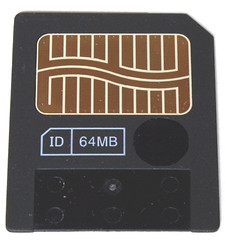Difference between revisions of "SmartMedia"
m |
(image add) |
||
| Line 1: | Line 1: | ||
{{stub}} | {{stub}} | ||
| − | '''SmartMedia''' is a form of [[flash memory]] card frequently used in [[digital camera]]s in the early 2000s. The format was developed by Toshiba | + | {{Flickr image |
| + | | image_source=http://www.flickr.com/photos/24225011@N04/3186146304/in/pool-camerapedia/ | ||
| + | | image=http://farm4.static.flickr.com/3530/3186146304_b77ce20e40_m.jpg | ||
| + | | image_align=right | ||
| + | | image_text=64Mb SmartMedia card | ||
| + | }} | ||
| + | '''SmartMedia''' is a form of [[flash memory]] card frequently used in [[digital camera]]s in the early 2000s. The format was developed by Toshiba. The package was a thin (about a third of a millimetre thick) plastic rectangle 45x37mm, with a corner cutoff for orientation. One side carried a surface contact area, and a marked circle where a metallic sticker could be placed for write protection. Capacities ranged from 512kb to 128Mb, and data transfer was limited to a rate of 2MB/s - small and slow by today's standards. The cards are no longer in production. | ||
[[Category: Camera parts]] | [[Category: Camera parts]] | ||
[[Category: Storage Media]] | [[Category: Storage Media]] | ||
Revision as of 22:25, 10 January 2009
This article is a stub. You can help Camera-wiki.org by expanding it.

|
| 64Mb SmartMedia card |
SmartMedia is a form of flash memory card frequently used in digital cameras in the early 2000s. The format was developed by Toshiba. The package was a thin (about a third of a millimetre thick) plastic rectangle 45x37mm, with a corner cutoff for orientation. One side carried a surface contact area, and a marked circle where a metallic sticker could be placed for write protection. Capacities ranged from 512kb to 128Mb, and data transfer was limited to a rate of 2MB/s - small and slow by today's standards. The cards are no longer in production.